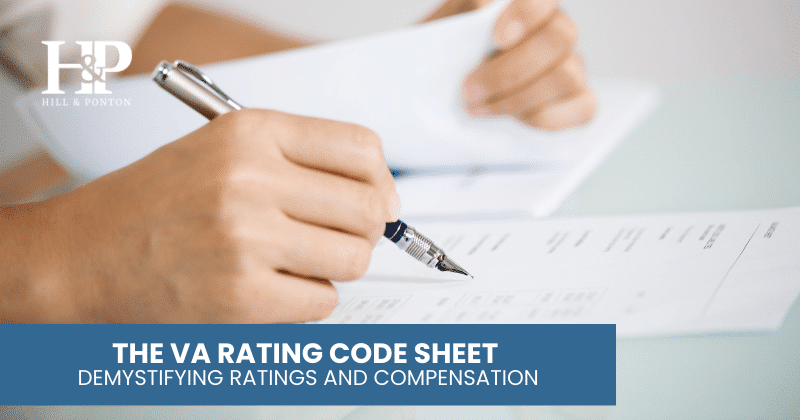If you’re applying for a service-connected VA disability, you’ve probably encountered the VA Ratings Table.
This tool determines combined disability ratings but can be frustrating.
If you have only one rated disability, the math is simple: your rating is your total disability rating.
But with multiple disabilities, it gets complex.
Enter the Combined Ratings Table!
Understanding this helps ensure you receive accurate disability benefits.
If you want a quick explanation about VA Math and the ratings table, watch our video below.
What do VA Disability Ratings Represent?
Understanding VA disability ratings and combined ratings begins with grasping what disability ratings mean.
Simply put, the VA assigns a percentage (like 20%, 50%, etc.) to each injury or illness, representing its severity.
Think of it this way: these ratings reflect how your disability affects your daily life, whether it’s interacting with family, working, or other activities.
Your rating is determined by:
- The evidence you give them (medical records and test results, personnel records, etc.)
- The results of your Compensation and Pension (C&P)/VA claim exam
- Other information obtained from other sources, like federal agencies, military records.
How does VA Math Work?
VA Math combines disability ratings for multiple conditions into one “combined” rating.
Imagine your body as 100%.
Each condition is a percentage of your total disability.
Here’s a simple step-by-step:
- Start with the largest rating (e.g., back injury at 30%). Subtract it from 100%.
- 100% – 30% = 70% remaining.
- Subtract the next rating (e.g., knee injury at 20%) from what’s left.
- 20% of 70% = 14%
- 70% – 14% = 56% remaining.
- Subtract the last rating (e.g., tinnitus at 10%) from the new total.
- 10% of 56% = 5.6%
- 56% – 5.6% = 50.4%.
- Round to the nearest 10 for the combined rating.
- 50.4% rounds to 50%.
It may seem confusing, but step-by-step, it hopefully becomes clearer.
How do I calculate my VA disability rating?
Disability compensation depends on your service-connected disability rating.
If you have multiple disabilities, your benefits are determined by your combined rating.
For instance, having a 20% disability and a 60% disability doesn’t mean your combined rating is 80%.
Important to note: combined ratings are NOT additive.
Instead of adding, the VA combines ratings by considering what percentage of disability a veteran has and what percentage they don’t.
How does the VA determine combined VA disability ratings?
Disability ratings follow the Schedule of Ratings, which assigns percentages based on symptom severity.
For example, a veteran’s PTSD can be rated as 0, 10, 30, 50, 70 or 100 percent.
When you have multiple disability ratings, the Combined Ratings Table is used to calculate your overall VA disability rating.
Remember, calculating this combined rating involves more than simple addition.
The Steps For Using the Combined Ratings Table
Step 1
Your disability ratings are put in order, from highest to lowest percentage.
For example: If you had 2 disabilities rated as 50% disabling and 30% disabling, they’d be ranked 50% and then 30%.
Step 2
Then, you’d look for your highest rating in the left column of the combined ratings table, and then the next highest rating in the top row of the combined ratings table.
For the same example: You would look for 50 in the left column and 30 in the top row.
[wpdatatable id=35]
Step 3
Then you would look from the 50 in the left column and down from the 30 in the top row, to find the number that appears where the left column and top row meet. This is the combined value of the two ratings.
In the same example: This would be 65.
[wpdatatable id=36]
Step 4
If you have 2 disabilities the combined value would be rounded to the nearest 10% to find your combined disability rating. The combined values ending in 1-4 are rounded down, and those 5 to 9, up.
For the same example: Your combined disability rating would be 70%
Step 5
If you have more than 2 disabilities the process is repeated for each additional disability. Which basically means, the combined value of the first two disabilities (before rounding) is combined with the third highest rating, and so on, until all disability ratings have been accounted for.
The final value is rounded to the nearest 10% to get your combined disability rating.
For example: If a third disability was added at 10% disabling, from the original example, you’d take your combined rating of 65 and then look for the number in the left column of the combined ratings table. You would look for 10 in the top row–and find the number where the left column and the top row meet. In our example, it would be 69.
[wpdatatable id=37]
Why Worry About All the VA’s Complicated Tables When We’ve Done the Work for You?
Navigating the VA’s complex disability rating tables to figure out multiple ratings can be overwhelming and confusing.
That’s where our VA Disability Calculator comes in – a tool specifically designed to save you time and effort!
With just a few clicks, you can gain insights into:
- Your Expected Disability Rating: No more guessing or trying to interpret complicated tables. Our calculator provides a clear estimation of the rating percentage for your specific condition or combined conditions.
- Your Potential Compensation: Understand the financial support you might be eligible for. Our calculator breaks down the compensation tied to various disability ratings, giving you a clear picture of your potential benefits.
Ready to find out what your VA disability rating and compensation could look like? Try it now.

The Alternative Path to Receiving 100% Disability
The VA makes it incredibly difficult to obtain 100% disability, but there is still hope–using what is called Total Disability Based on Individual Unemployability (TDIU).
This is specifically for veterans who cannot work but don’t have 100% disability.
If you meet the following criteria, you should consider applying for TDIU:
- One service-connected disability rated at 60% or two or more service-connected disabilities, at least one rated at 40 percent or more, with a combined rating of 70 percent or more.
- Unable to maintain substantially gainful employment as a result of service-connected disabilities
Cassandra Crosby, an Accredited Agent and claims advocate for Matthew Hill & Shelly Mark’s teams, reviewed the information provided in this post.


